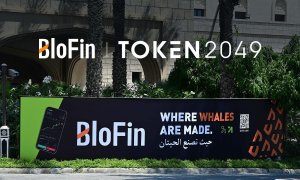How do you bring options trading to the blockchain?
Options trading is on the surge. But before getting started, it is important investors understand how it works and what it is.

Options allow traders to buy or sell contracts that give them the right, but not the obligation, to buy or sell an underlying asset at a certain price and within a specified time frame. Such contracts are commonly used to speculate on the price movement of stocks, indices and commodities.
In general, there are two types of options: call options and put options. A call option gives the holder the right to buy an underlying asset at a certain price, while a put option gives the holder the right to sell an underlying asset at a certain price.
In March 2023, the Options Clearing Corporation saw a record-breaking increase in the number of contracts it cleared, with the number of contracts cleared surpassing 1 billion. This represents a 12.2% increase compared to the same period last year. While March’s volume was the highest ever recorded by the organisation, it was also the first time in history that the volume of cleared contracts exceeded 1 billion in a single month.
The data shows a potentially bullish future for options trading, which has been traditionally done through centralised exchanges or brokerages. However, centralised brokerages offer options trading a number of limitations in the likes of high fees, limited trading hours and a lack of transparency.
In addition, options contracts are often complex, gated and capital intensive, making it difficult for smaller traders to participate.
However, there are newer platforms and technologies emerging that aim to address these limitations and make options trading more accessible to a wider range of traders. Specifically, I am talking about decentralised versions of options trading venues which are being developed to allow traders to trade options directly with each other and without the need for a centralised intermediary.
Such platforms can offer lower fees 24/7 trading and greater transparency.
For fully on-chain (meaning: the entire options protocol is written purely in terms of smart contracts, as opposed to off-chain systems like regular servers as we know it in the current financial system) options trading on blockchain-based platforms smart contracts are used, which are contracts with the terms of the agreement between buyer and seller directly written into the code itself which offers the highest level of safety to all participants. Such smart contracts can automate the entire options trading process including the execution and settlement of trades.
On a blockchain-based platform, options traders can create, buy, and sell options contracts using cryptocurrency as collateral. Meanwhile, the smart contract ensures automatically that the contract terms are enforced, and the collateral is held in escrow until the contract is executed or expires.
Once the contract has been executed, the smart contract automatically releases the collateral and the payout to the appropriate parties. This process eliminates the need for intermediaries, such as brokers or exchanges, and reduces the time and cost associated with settling trades.
One such example of blockchain-based options trading was developed by the Panoptic team, which created an algorithm and platform that allows for 24/7 decentralised options trading on the blockchain.
However, developing a protocol for options trading on the blockchain is not without its challenges and navigating regulations is one of its biggest obstacles.
The regulatory framework for options trading on the blockchain is still evolving, and traditional financial regulations may not always be applicable or sufficient to govern blockchain-based trading activities.
In recent weeks, the industry has seen a series of unfortunate “regulation by enforcement” moves from the US Securities and Exchange Commission (SEC). This is not the preferred approach to building out a healthy financial ecosystem, and the regulators are facing push backs from the Senate.
This means that blockchain-based options trading platforms should navigate the complex regulatory landscape carefully. They may need to work closely with regulatory bodies to ensure that they are compliant with applicable laws and regulations. Some platforms may also opt to restrict access to certain jurisdictions where regulations are unclear or restrictive.
Furthermore, developing a protocol for options trading on the blockchains requires a ton of engineering work. This includes developing smart contracts to automate options trading, designing user interfaces that are easy to use and ensuring the security and scalability of the platform.
Despite this, the benefits of options trading on the blockchain are clear.
Decentralised options trading allows for greater accessibility and lower barriers to entry, allowing anyone, including smaller traders, to participate in the market. In addition, by using cryptographic algorithms and decentralized networks, blockchain options trading platforms can provide secure and tamper-proof trading environments. This enhanced security helps to reduce the risk of fraud, hacking, and other types of cyber-attacks, which are significant concerns in traditional options trading.
Moreover, the transparency and immutability of transactions on the blockchain provide greater security and trust in the trading process. On top of that, blockchain options can also offer greater speed and efficiency compared to traditional options trading when the blockchain ecosystems are fully built out in the next few years. This increased efficiency can lead to lower transaction costs and faster settlement times, making blockchain options trading an attractive option for traders looking for faster and more cost-effective trading options.
In addition, blockchain options trading can offer increased flexibility compared to traditional options trading. Smart contracts can be customised to meet the needs of individual traders, with different contract terms and settlement options. This increased flexibility can help traders to better manage their risk and take advantage of market opportunities more efficiently. It will also help institutions and sophisticated investors better program and manage their portfolios.
There’s no doubt that as blockchain technology continues to evolve, we can expect to see more innovation within the options trading space. With the Panoptic algorithm and other initiatives like it, we can look forward to a future where options trading is more accessible, transparent and secure than ever before.

Jesper Kristensen holds a Ph.D in Applied Physics and Computer Science from Cornell University and has previously led a large Web3 Research Organisation. Jesper also co-authored a book on Automated Market Makers: A Practical Guide to Decentralized Exchanges and Cryptocurrency Trading.
The subject matter and the content of this article are solely the views of the author. FinanceFeeds does not bear any legal responsibility for the content of this article and they do not reflect the viewpoint of FinanceFeeds or its editorial staff.









